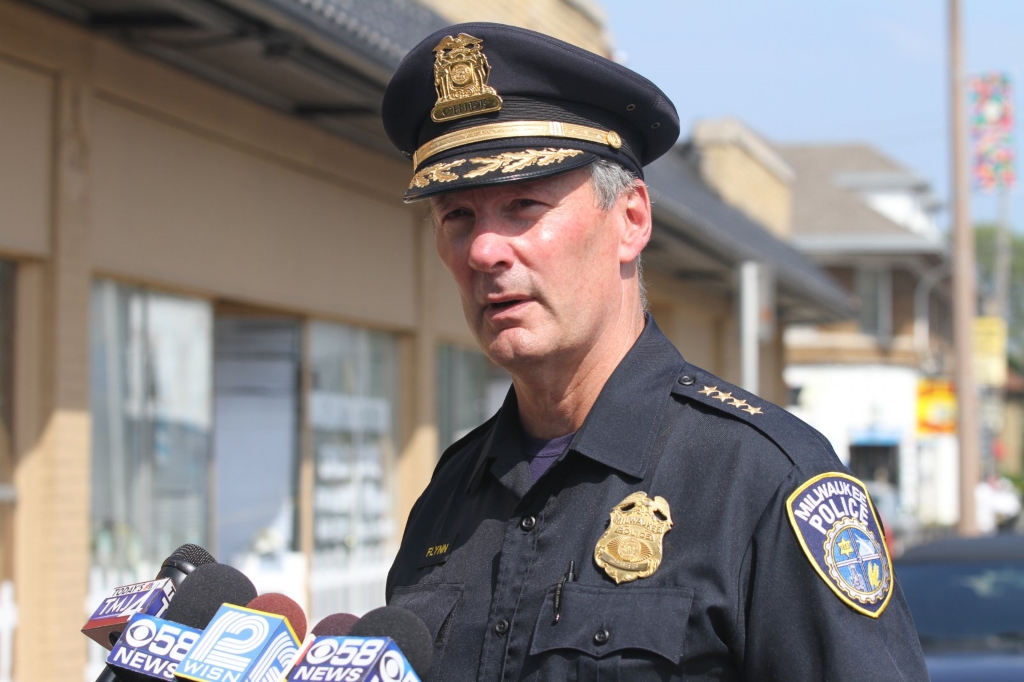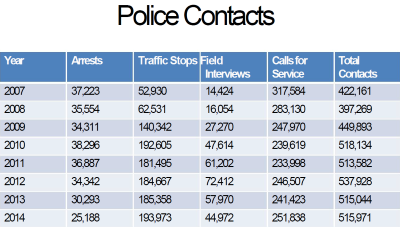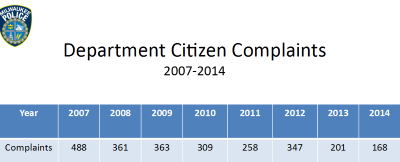Does “Broken Windows” Theory Hurt Milwaukee?
Police Chief Ed Flynn is one of the foremost practitioners of aggressive policing getting national criticism.
In the wake of Ferguson and other cities where African Americans died in the custody of police, including Dontre Hamilton in Milwaukee, the police have been under fire nationally. Questions have been raised about the “Broken Windows” theory and other aggressive policing approaches. These have a “dark side,” New York Times writer Ginia Bellafante has argued.
She notes that advocates for police reform delivered testimony to President Barack Obama’s Task Force on 21st-Century Policing condemning the Broken Windows approach. And she quotes Michael Jenkings, an author and professor of criminal justice at the University of Scranton, who says: “If police are viewed as intervening across the board everywhere or viewed as carpet-bombing an area, that’s usually not going to be helpful to community relationships.”
The Broken Windows theory, first articulated in 1982 by James Q. Wilson and George L. Kelling, argued that signs of disorder in a neighborhood — a broken window, rowdy teenagers, a drunken panhandler, graffiti or litter in the neighborhood — breed a more friendly climate for crime. For Flynn it was like a light bulb went off: for years he had attended meetings in high crime neighborhoods where the overwhelming percentage of complaints were about these seemingly minor matters. The theory also argued that by going after small offenses, you often nab bad actors who are engaged in bigger crimes.
Beginning in 1994, New York Police Chief William J. Bratton launched an approach that targeted bad neighborhoods and criminals with a CompStat system using day-to-day data on crimes to zero in on problems. A huge drop in crime occurred. Since then, the most successful police chiefs have increasingly become social scientists who use computer data and information from police on the beat to understand all the conditions breeding crime and to measure their success.
Flynn has become a national leader in this kind of policing and can tick off all the statistics for his department. His approach, not unique to Milwaukee, also includes aggressive use of traffic stops of cars that might have expired licenses, equipment violations or seat-belt violations by drivers, in hopes of nabbing bad guys. When he took over in Milwaukee in 2007, police were making just under 53,000 traffic stops per year; that’s risen to more than 185,000 per year in the last three years. Police did less than 15,000 field interviews in 2007; that’s risen to more than 58,000 annually over the last three years.
Flynn’s statistics show an overlap between high poverty and heavily minority city neighborhoods, and areas with high crime and a high number of calls for service. Crime tends to be heavily concentrated in certain neighborhoods, even on certain blocks, and a small number of criminals commit a huge percentage of all crimes. So the task of law enforcement is to target police contacts to those areas, to find those criminals.
Much of Flynn’s approach was based on the New York experience, but now that process is being reversed as representatives of the NYPD came to Milwaukee last July to study how our CompStat system works. The teachers are now learning from the former students.
“The New York officers were struck by the fact that our citizen contacts (traffic stops and field interviews) had grown four-fold while our citizen complaints had declined,” Flynn says. Citizen complaints declined from nearly 500 in 2007 to about half that per year over the last three years.
From the beginning, Flynn says, “our instructions to officers was to use aggressive traffic enforcement as a crime prevention strategy. Our goal was to disrupt the crime process by being highly visible in high-crime neighborhoods.”
“We knew if we weren’t careful,” he continues, “that we would be imposing a poor people tax because a high-crime neighborhood is a poor neighborhood.” So officers were urged early on in the process to avoid criminalizing minor offenses. “The preferred outcome of a traffic stop is a warning,” Flynn says. “80 percent of our stops are warnings.”
Later, the process was further refined. “We were getting a large number of marijuana arrests.” Cops would ask permission to search the car and the driver would usually say yes — even if there was marijuana somewhere in the car.
Given national statistics showing blacks are far more likely to be arrested for marijuana possession even though surveys show similar usage of the drug by whites and African Americans, Flynn adjusted the policy. Now cops are instructed to ask to search the car only if there is probable cause to believe a crime is being committed.
“The New York police were interested in both the adjustments we made in our traffic stops,” Flynn notes.
The approach is about far more than nabbing bad guys. As Flynn has often emphasized, the department’s goal is to transform high-crime neighborhoods, which are also the places with all those broken windows and graffiti.
To that end, Flynn’s team has successfully applied for national grants to build neighborhoods. In August 2012, the department won a $225,000 grant from the Building Neighborhood Capacity Program, part of White House’s Neighborhood Revitalization Initiative. Milwaukee was one of four cities to receive a grant from the program. (The others are Memphis, Flint, MI. and Fresno, CA.) “We were the only city where the lead agency was the police department, not the city, for the grant,” Flynn notes.
Just a month or so later the Milwaukee Police were awarded a $600,000 Byrne Criminal Justice Innovation award from the federal Department of Justice. “We were the only city to get both grants,” Flynn brags.
Under the first grant, the police work with neighborhood non-profits to improve safety and enhance services in two north-side neighborhoods. Under the second grant, the police will work with local non-profit agencies to revive the Washington Park neighborhood.
“I think one of the reasons we don’t have the kind of mass protests you’ve had in other cities is because at the grass-roots level in Milwaukee the support for the police is high,” Flynn says. “Our Broken Windows strategy was never as aggressive as in New York City.”
A recent survey offers some validation of this contention. Conducted by the UWM Center for Urban Initiatives and Research, and commissioned by the Milwaukee Fire & Police Commission, the City of Milwaukee Police Satisfaction Survey found that 74.3 percent of city residents report being “very” or “somewhat satisfied” with the Milwaukee Police Department while just 25.8 percent are “not very” or “not at all satisfied.”
The big difference comes from residents who were searched or arrested during their most recent officer-initiated contact with Milwaukee police; about 38.1 percent of those who were arrested expressed satisfaction with the department, while just 19.4 percent of those who were searched or patted down expressed satisfaction.
As Flynn would be the first to say, the police walk a tightrope when aggressively policing high-crime neighborhoods. Residents desperately want and need more safety, but they want the police to carefully distinguish between the good and bad actors. That’s not always easily done. That’s the continuing challenge for Flynn, but a wide range of data — including the big drop in crime since he took over — suggests the department has made great strides in making this a safer and better policed city.
Short Take
Flynn bemoans the national media’s feeding frenzy on the issue of how police are handling black suspects. “The national press has been covering the police like it’s an aggressive, soul-less monolith. That’s had an affect on officer morale across the country, including in Milwaukee,” he says.
“From April to August the Dontre Hamilton story was a mental health story. Then Ferguson took place. Suddenly it was a racial issue. There was an attempt by protest organizers to fit this into the Ferguson narrative.”
Flynn ended up firing the police officer, Christopher Manney, who killed Dontre Hamilton, but protestors have been outraged that Milwaukee County District Attorney John Chisholm has not pressed criminal charges against Manney. Meanwhile the police union has blasted Flynn and released a survey showing a large number of police objected to the firing.
Yes, it’s a complicated issue that we all may have different views of, which is why it’s so important to at least understand the department’s approach to policing.
Murphy's Law
-
The Last Paycheck of Don Smiley
 Dec 17th, 2025 by Bruce Murphy
Dec 17th, 2025 by Bruce Murphy
-
Top Health Care Exec Paid $25.7 Million
 Dec 16th, 2025 by Bruce Murphy
Dec 16th, 2025 by Bruce Murphy
-
Milwaukee Mayor’s Power in Decline?
 Dec 10th, 2025 by Bruce Murphy
Dec 10th, 2025 by Bruce Murphy

























This reminds me of a discussion I heard on NPR earlier this week. Fresh Air interviewed author and LA Times reporter Jill Leovy about her book “Ghettoside: A True Story Of Murder In America.” It’s a really interesting interview and sounds like a fascinating book. Generally speaking, her contention is that many black communities suffer not from over-policing but from too little policing. To quote NPR: “Her new book focuses on the epidemic of unsolved murders in African-American neighborhoods in Los Angeles and the corrosive impact of unpunished crime in those communities.
Leovy’s covered crime for the Los Angeles Times for more than a decade, and as you’ll hear, she doesn’t regard the problem simply as one of poor police work. Part of the problem, she believes, is that these murders are simply invisible to too many of us. In 2007, she started a blog called “The Homicide Report” to document all the murders in Los Angeles County.”
http://www.npr.org/2015/01/26/381589023/ghettoside-explores-why-murders-are-invisible-in-los-angeles
Glen Frankovis and David Clarke, formerly leaders in the police dept have laid out a plan for the city of Milwaukee to get out of the top ten most violent. You need the Mayor, top Judge, Abele and the DA to prosecute gun crimes while at the same time whining about registering guns in Crandon, wi. But they let everyone out of jail, prosecute only 50% of the gun crimes and Milwaukee goes on.
This takes precedence over an Arena and a trolley. go to Facebook: Wisconsin Conservative digest for details on trolley.
One factor often overlooked in these discussions: insofar as minor offenses are kept track of, more active policing of “high crime” areas tends to reinforce the notion that they *are* “high-crime areas”…because, obviously, with more police presence and enforcement, more crimes will be found.
I am not denying that some neighborhoods have higher crime rates – but I will note that one negative effect of statistics-based policing is a distortion in the frequency of minor crimes in non-targeted neighborhoods. Police will discover these crimes in targeted neighborhoods, whereas in non-targeted areas, they would find out about them only when there are complaints.
The data gleaned from police interactions is, therefore, not an accurate reflection of the frequency of all crime in the neighborhood.
Objective of broken windows theory is prevention, not apprehension. Our problem is the judges and the DAs want to be politically correct and not put too many minorities in ail. The result is such that the people committing all the crimes have long list of criminal actiivity yet are not in jail.
No. Milwaukee needs to control its crime rates and maybe more importantly its perception problems. I support the police cracking down on the people causing all the problems in this city.
WCD what gun crimes aren’t being prosecuted? Felon in possession of a firearm, stuff like that? What do Clarke and Frankovis say about drug crimes? Do they believe in strong prosecution of say possession of marijuana? Or do they zero in on violent crime/criminals?
The issue with Milwaukee are areas outside the places police are concentrated. These are the few places with some taxable value left. They also face huge challenges because they are not high on the list of desirable neighborhoods for young families. These places should be as equally important to police as are the high crime zones.
So Bob Dohnal (aka WCD aka Barrett Pharma), we should deploy the police to where there isn’t crime? Wow, you’ve got one hell of a brain trust over there at Wisconsin Conservative Digest… putting that Koch money to good use, huh?
Tim, have no idea who Barrett’s RPh is. PMD, Media Trackers tracked all arrests this summer and only half of those crimes where guns were used got prosecuted for that. In Chicago only 6% of ciminals that used guns ended up in jail. wonder why this is shooing gallery?
If that’s true then yes I agree that is a serious problem.
What do Clarke and Frankovis say about drug crimes? Do they believe in strong prosecution of say possession of marijuana? Or do they zero in on violent crime/criminals?
@PMD…. Someone is being prosecuted for something because we have the highest incrceration rates for African Americans in the country. Maybe less prosecution for non violent crimes.
Just came across these survey results from the ACLU which some readers may find interesting: http://aclu-wi.org/sites/default/files/media/pdf/2015_1_20ReportSummary.pdf.
Compare this to what Chief Flynn says as quoted above: “People in unsafe neighborhoods want a base level of civility and they don’t want to be afraid. These are areas that have lost the capacity for informal social control of a neighborhood. We’re trying to identify people in these neighborhoods (who want to improve things) and give them leadership training. In some capacity, police have to do nation building in these neighborhoods.”
In my experience, there are Milwaukee police officers who are simply outstanding. I have seen them in very difficult situations and they have performed incredibly. I have also had experience with officers who did not perform well, some who treated people with disrespect and sometimes worse. So is it a question of effective administration? How do you support and promote the careers of good officers and root out the bad ones?